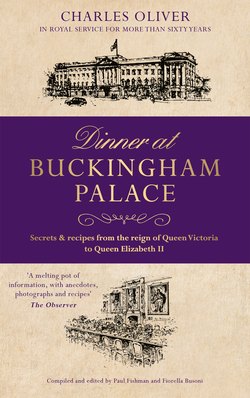Читать книгу Dinner at Buckingham Palace - Secrets & recipes from the reign of Queen Victoria to Queen Elizabeth II - Charles Oliver - Страница 28
На сайте Литреса книга снята с продажи.
THE JOCKEY CLUB DINNER BUCKINGHAM PALACE, DERBY DAY, 30 MAY 1906
ОглавлениеTortue claire
Crème de Pois Comtesse
Madeira 1816
*
Whitebait au Naturel et à la Diable
Suprêmes de Truites à la Valenciennes
Forster Jesuitengarten 1875
*
Zéphires de Cailles à la Montagné
G. H. Mumm 1892
*
Hanches de Venaison, Sauce Aigredoux
Selle d’Agneau froide à la Niçoise
Pommes de Terre à la Jaucourt
Chambertin 1875
*
Ortolans Rôtis
Poussins sur Canapés
Salade de Coeurs de Romaines
Still Sillery 1865
*
Asperges d’Argenteuil, Sauce Mousseline
Pêches à la Reine Alexandra
Pâtisseries à la Parisienne
Château Lafite 1873
*
Cassolettes à la Jockey Club
*
Petites Glaces Printanières
Friandises
*
Dessert
Port 1812 (King of Portugal)
Port 1834
Château Margaux 1871
A comparison of two Derby Day menus shows a certain consistency, though whether the choice of food reflects the King’s preferences or those of the Jockey Club members is a matter for conjecture. Turtle soup was on the menu in 1902 and again in 1906, as were whitebait, trout, venison, lamb, quail, asparagus; and also one dish which would today be highly controversial: ortolans, whether on canapés or roast. However delicious these little songbirds are said to be, most people would rightly be horrified at the thought of ortolan buntings being trapped, force-fed, drowned in Armagnac, and served as part of a meal, traditionally eaten whole. (The birds are now protected across the European Union.)
Much more acceptable is the peaches dish, Pêches à la Reine Alexandra, named in honour of Edward’s queen, a variation of Escoffier’s 1890s creation for the Australian soprano Nellie Melba, using redcurrant sauce instead of raspberry. Cassolettes à la Jockey Club were presumably a must for Jockey Club dinners, the little individual dishes usually containing, according to The Menu Book (1913 edition) by Charles Herman Senn, ‘finely cut strips of celery, cold potatoes, cooked French beans, preserved mushrooms, gherkins and lettuce hearts, dressed with mayonnaise; garnished with anchovy fillets and hard-boiled eggs’.
The Derby was won in 1902 by a horse called Ard Patrick, and in 1906 by a horse named Spearmint. Edward VII himself owned three Derby winners in his lifetime: the 1896 winner, Persimmon, and Diamond Jubilee (born in 1897, the year of Queen Victoria’s Diamond Jubilee) when he was Prince of Wales, and Minoru, who won in 1909. To date, Edward VII is the only reigning British monarch to own a Derby winner.
During visits to the theatre or opera, Edward would insist on a one-hour interval so that he could fully appreciate his supper, served in the royal box. The six royal hampers packed for such occasions contained such items as cold clear soup, lobster mayonnaise, cold trout, plovers’ eggs, cold duck, chicken, lamb cutlets, ham and tongue, a selection of sandwiches, a choice of some four desserts and Parisian pastries. Gold plate was taken along as well to remind the King that it was a royal meal, even if it came out of hampers.
Such dedication to food could not do anyone any good, and as the King was also a smoker, it was inevitable that that his health would suffer. He suffered from worsening bronchitis during his last years but refused to stop working until a series of heart attacks confined him to the palace, where he died on 6 May 1910. As he drifted in and out of consciousness, his son Prince George came in to give him the news that his horse, Witch of the Air, had won at Kempton Park; he answered, ‘Yes, I have heard of it. I am very glad.’ These are said to be the King’s last words.
Edward’s eldest son having died in 1892 of flu-induced pneumonia, he was succeeded by Prince George, who reigned as George V.
